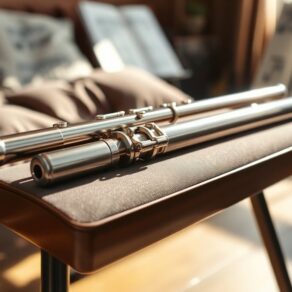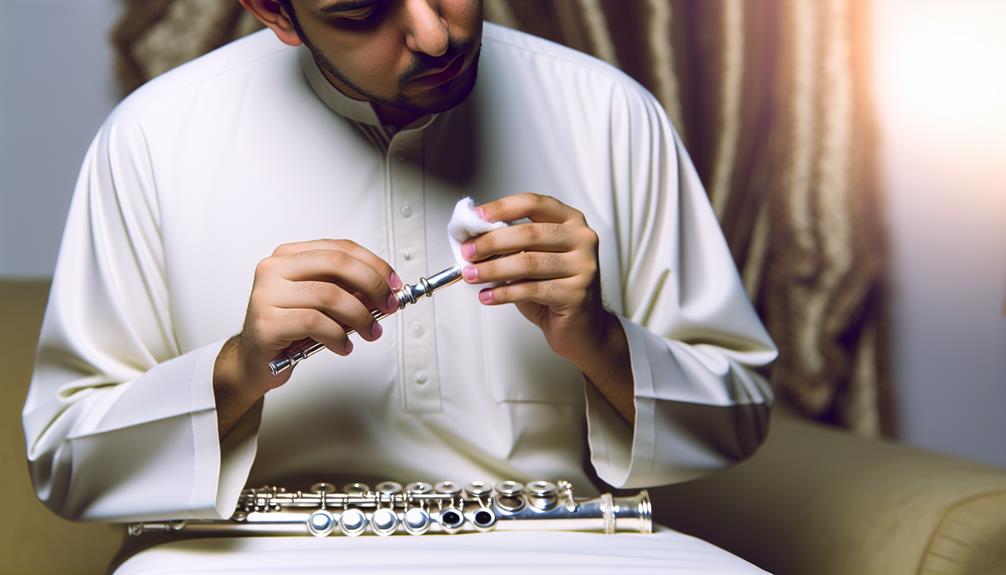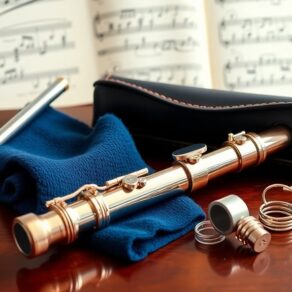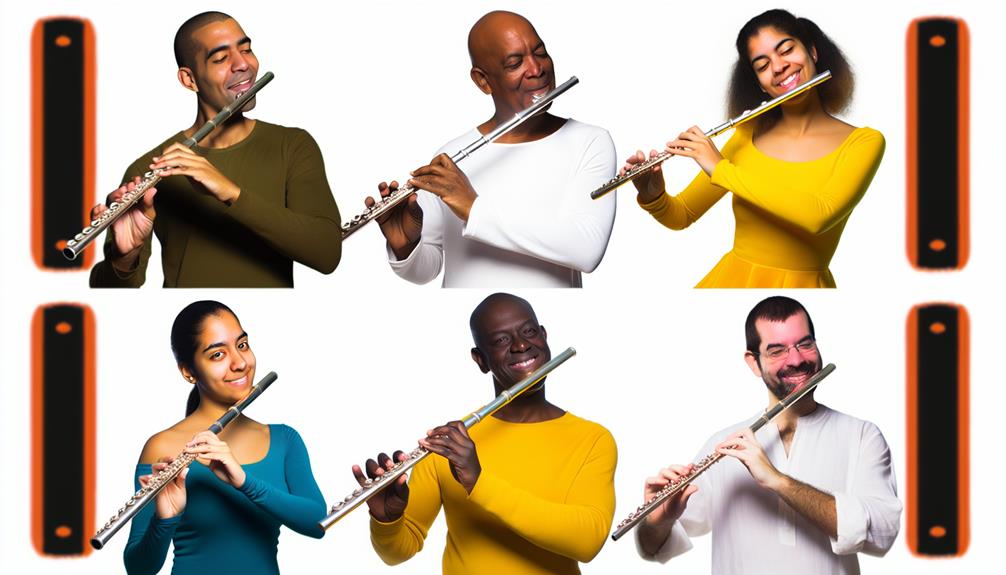Understanding the intricacies of flute embouchure is akin to unlocking a world of musical possibilities. From the subtle nuances of tone quality to the precise control required for flawless articulation, mastering this fundamental aspect of flute playing is paramount. As we explore the foundational techniques and advanced strategies outlined in this guide, we will unravel the secrets to achieving a truly exceptional level of artistry and finesse in our musical performances.
Key Takeaways
- Master basic techniques for strong embouchure foundation.
- Develop correct mouth shape for optimal sound production.
- Strengthen embouchure with breathing exercises for control.
- Focus on meticulous airflow control for tone quality.
- Troubleshoot common issues like air pressure and lip tension.
Importance of Flute Embouchure
Understanding the significance of proper flute embouchure is fundamental for achieving optimal tone production and control while playing the flute. The embouchure refers to the way a flutist shapes their lips, facial muscles, and mouth to produce sound. It is a critical aspect of flute playing that can greatly impact a musician's performance.
Improving endurance is one of the key benefits of having a strong flute embouchure. A well-developed embouchure allows the flutist to play for longer periods without fatigue. By maintaining a consistent and stable embouchure, a musician can sustain their tone quality and control throughout extended practice sessions or performances. This endurance is essential for mastering challenging pieces and delivering captivating musical performances.
Precision in articulation is another crucial aspect of flute playing that is directly influenced by the embouchure. A precise embouchure enables the flutist to articulate notes with clarity and accuracy. By controlling the airstream and the shape of the embouchure, a musician can achieve crisp and clean articulations, enhancing the overall musicality of their performance. This precision is vital for executing intricate passages, achieving dynamic contrast, and expressing musical nuances effectively.
Basic Lip Position Techniques
Proper execution of basic lip position techniques is foundational to developing a strong and effective flute embouchure. Lip flexibility and breathing control are essential components when mastering these techniques. Achieving the correct lip position involves maintaining a balance between firmness and flexibility. To enhance lip flexibility, engage in embouchure exercises that focus on controlling the muscles around the lips. Practice varying the tension in your lips to explore different tones and sounds, gradually increasing the range of flexibility.
Breathing control plays a significant role in tone production. When positioning your lips, ensure that your air stream is directed correctly across the embouchure hole to produce a clear and resonant sound. Practice breathing exercises to strengthen your diaphragm and control the airflow while playing the flute. Consistent airflow is crucial for sustaining notes and achieving a smooth sound.
Embouchure exercises are beneficial for developing muscle memory and improving tone production. Focus on maintaining a stable lip position while playing long tones to build endurance and control. Experiment with different lip shapes and positions to discover the optimal setup for your embouchure. By mastering basic lip position techniques, you lay a solid foundation for building a strong and versatile flute embouchure.
Correct Mouth Shape Formation
Developing the correct mouth shape formation is pivotal in mastering the nuances of flute embouchure technique. Embouchure flexibility and mouth flexibility are essential components in creating the optimal sound production on the flute. To achieve the ideal mouth shape, begin by forming a small, oval aperture with your lips. This shape allows for better control of airspeed and direction, which are crucial in producing clear and resonant tones. Additionally, maintaining proper lip tension is key to achieving a balanced sound.
Too much tension can restrict airflow, leading to a strained and pinched sound, while too little tension can result in a weak and airy tone. Finding the right balance will help you produce a rich and vibrant sound on the flute.
Experiment with different mouth shapes and lip positions to discover what works best for you. Remember to keep your corners firm to support the sound and prevent air leaks. Pay attention to the sensation in your embouchure as you play different notes, adjusting your mouth shape and lip tension accordingly. Consistent practice and mindful attention to detail will help you develop a strong and reliable embouchure that allows for effortless control of airspeed and tone production. Mastering the correct mouth shape formation is a foundational step towards achieving proficiency in flute playing.
Developing Embouchure Strength
To enhance your flute playing technique and achieve greater control over your sound production, focusing on strengthening your embouchure is a fundamental aspect of your musical development. Developing embouchure strength involves a combination of breathing exercises and muscle relaxation techniques that will not only improve your endurance but also refine your tone quality.
Breathing exercises play a crucial role in enhancing your embouchure strength. Practicing deep breathing techniques, such as diaphragmatic breathing, can help you develop the necessary breath support for sustaining long phrases and playing with consistency. By engaging in daily breathing exercises, you can strengthen the muscles involved in controlling airflow, leading to a more powerful and controlled sound production.
In addition to breathing exercises, muscle relaxation is key to building embouchure strength. Tension in the facial muscles can impede your ability to play with ease and fluidity. Incorporating relaxation techniques, such as gentle massages or facial stretches, into your practice routine can help release any unnecessary tension and promote greater flexibility in your embouchure muscles.
Enhancing Tone Quality
Achieving a rich and resonant tone quality on the flute requires meticulous attention to embouchure control and breath support. Proper breath control is fundamental in producing a beautiful tone that resonates with clarity and warmth. To enhance tone quality, flutists must focus on mastering the art of controlling their breath while maintaining a stable embouchure.
Breath control is the cornerstone of tone production on the flute. By developing the ability to regulate air support, flutists can achieve a consistent and full-bodied sound. It is essential to cultivate a deep understanding of how to engage the diaphragm and control the speed and volume of airflow. This control allows for dynamic variations and sustained notes that are rich in tone color.
In addition to breath control, attention to embouchure is crucial for enhancing tone quality. The embouchure serves as the gateway for the air stream, shaping and directing it to produce different tones. A stable embouchure that is properly formed and aligned enables the flutist to achieve a clear and focused sound. By refining embouchure technique through consistent practice and mindfulness, flutists can unlock a wide range of expressive possibilities in their tone production.
Controlling Airflow and Dynamics
Mastery of airflow control and dynamics is essential for achieving a nuanced and expressive flute performance. Airflow control refers to how a flutist manages the speed and direction of the air moving through the instrument, directly impacting the sound produced. By adjusting the air speed and direction, a player can create a wide range of tones and dynamics, bringing life and emotion to their music.
To control airflow effectively, proper breath support is crucial. A flutist must engage their diaphragm and abdominal muscles to maintain a steady stream of air while playing. This support allows for consistent airflow, leading to a more stable and controlled sound. Experimenting with different air pressures and angles can help in discovering the optimal airflow for achieving desired tones and dynamics.
Dynamic range, the variation in loudness and intensity of the sound produced, is another vital aspect of flute playing. Controlling dynamics adds depth and emotion to a musical performance, creating contrasts that keep the audience engaged. By adjusting airflow and embouchure, a flutist can seamlessly transition between soft, delicate pianissimo passages and powerful, resonant fortissimo sections.
Developing a keen awareness of airflow control and dynamic range empowers flutists to convey a wide range of emotions through their music, captivating listeners and delivering memorable performances.
Troubleshooting Common Embouchure Issues
Understanding and addressing common embouchure issues is crucial for flute players seeking to optimize their performance and sound quality. Troubleshooting these issues can significantly enhance one's playing experience. Here are some key points to consider:
- Air Pressure:
Maintaining proper air pressure is essential for producing a clear and resonant sound. Too much air pressure can cause a harsh tone, while too little can result in a weak sound. Finding the right balance is crucial for achieving a rich and vibrant tone that carries throughout the performance.
- Lip Tension:
Proper lip tension is vital for controlling the pitch and tone quality. Excessive tension in the lips can lead to a pinched sound, while insufficient tension may result in a flat or dull tone. Developing a relaxed yet firm embouchure is key to producing a well-rounded and expressive sound on the flute.
- Embouchure Alignment:
Ensuring proper alignment of the embouchure hole with the lips is essential for achieving clarity and accuracy in pitch. Misalignment can cause pitch discrepancies and hinder tone production. By carefully positioning the flute and adjusting the angle of the airstream, players can optimize their embouchure alignment for improved performance.
- Consistent Practice:
Consistent practice is key to overcoming embouchure issues and refining one's technique. By dedicating time to daily exercises focused on embouchure development, flute players can strengthen their muscles, improve control, and ultimately enhance their overall playing experience. Regular practice sessions tailored to address specific embouchure challenges can lead to significant improvements in sound quality and performance proficiency.
Advanced Techniques for Mastery
Mastering the intricacies of advanced flute techniques requires a deep understanding of nuanced embouchure control and refined breath management. To achieve mastery, flute players must delve into the realm of embellishment techniques and precision control, elevating their playing to new heights.
Embellishment techniques add depth and beauty to music, allowing the flutist to express emotions with greater clarity. Techniques such as vibrato, trills, and grace notes require precise embouchure adjustments and controlled airspeed. Vibrato, for example, involves subtle variations in pitch that can enhance the emotional impact of a melody. Trills, rapid alternations between two notes, demand quick fingerwork and impeccable breath control. Grace notes, quick ornamentations before a main note, require finesse and agility in embouchure formation.
Precision control is paramount in mastering advanced flute techniques. It involves honing the ability to produce consistent tone quality across all registers, execute rapid articulations with clarity, and navigate intricate passages with ease. Achieving precision control requires dedicated practice, attention to detail, and a keen ear for intonation.
Frequently Asked Questions
How Does Temperature Affect Flute Embouchure?
Temperature can affect flute embouchure by influencing lip hydration and muscle relaxation. In colder climates, lips may dry out faster, affecting tone production and control.
Proper warm-up techniques can help combat this issue by increasing blood flow to the muscles and improving breath control.
Can Braces Impact Flute Embouchure?
Braces can indeed impact flute embouchure. They may affect oral hygiene, requiring diligent care to prevent issues. Lip sensitivity can also pose challenges, as braces can cause discomfort when playing.
Adjusting to braces while maintaining proper embouchure technique is crucial; regular practice and patience are key. Consult with a music teacher or orthodontist for guidance on adapting to braces and ensuring optimal flute performance despite these challenges.
What Role Does Tongue Position Play in Embouchure?
Tongue placement in flute embouchure is pivotal for controlling airflow and achieving optimal sound production. The flexibility of the embouchure is greatly influenced by the position of the tongue, which affects articulation and tone quality.
Is There a Recommended Daily Practice Routine for Embouchure?
Incorporating a daily practice routine for embouchure can significantly enhance flute playing skills. Begin with gentle breathing exercises to develop breath control and mindfulness.
Follow up with lip flexibility exercises to improve embouchure strength and agility.
Consistency is key; aim for a balance of technique drills and musical expression in your practice routine.
How Can One Prevent Fatigue While Practicing Flute Embouchure?
To prevent fatigue while practicing flute embouchure, it is essential to focus on breathing techniques and relaxation. Incorporating proper breathing patterns can help distribute the workload more evenly, reducing strain on specific muscles.
Additionally, taking breaks during practice sessions can improve muscle endurance and prevent overexertion. By incorporating these strategies into your routine, you can maintain a healthy embouchure and enhance your overall flute performance.
Conclusion
In mastering flute embouchure, the importance of foundational techniques, correct mouth shape formation, and developing strength cannot be overstated.
By focusing on enhancing tone quality, controlling airflow, and troubleshooting common issues, one can achieve mastery in flute playing.
With dedication and practice, one can unlock the full potential of their flute playing abilities, leading to a more nuanced and expressive performance that captivates both the player and the audience.





